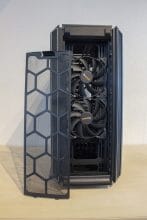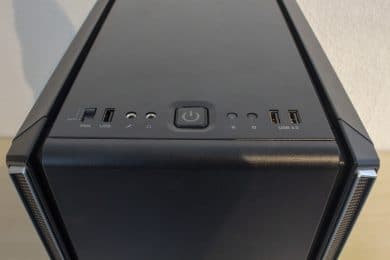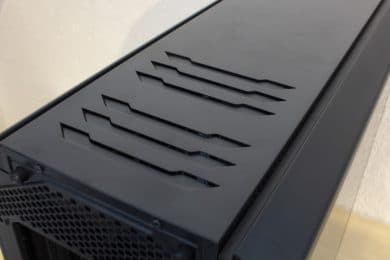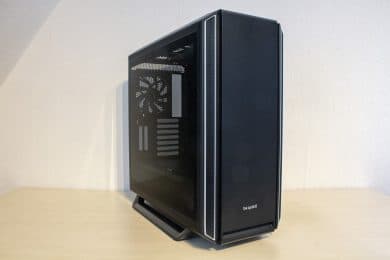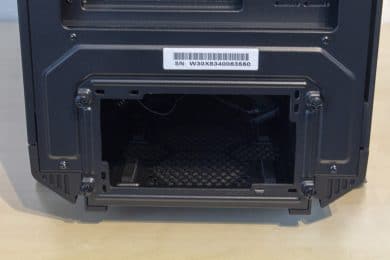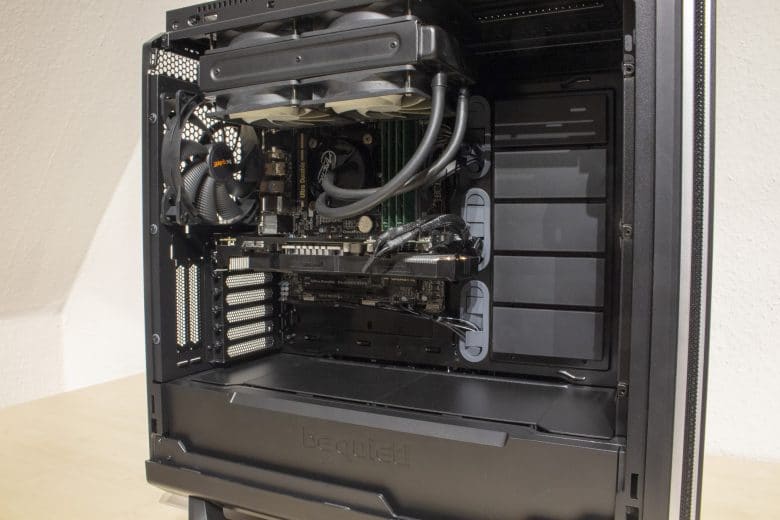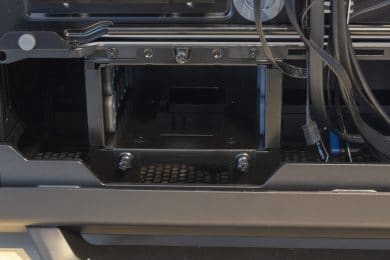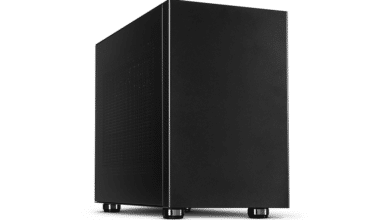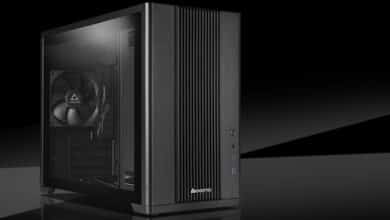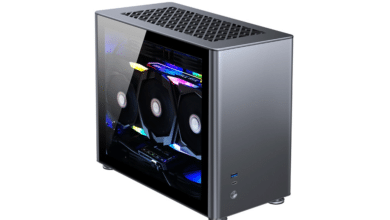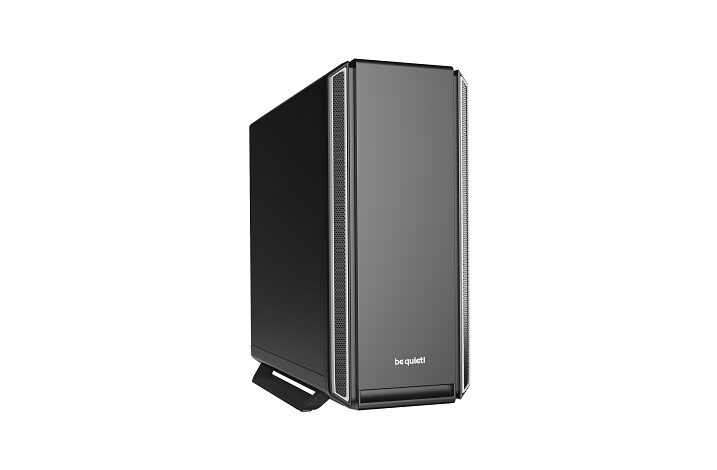
At Computex 2018 be quiet! presented a refresh for three case series. One of these cases was the be quiet! Silent Base 800. The recently released successor is called Silent Base 801 and is available in six different versions. There are a total of three colors (Orange, Silver*, Black) and two different variants for each color. The first variant has two completely closed and insulated side parts. In the second variant, be quiet! replaced the insulated left side panel with a tempered glass pane. The price of the version without window is currently Product. For the version with page window about 10 € more are due. Further interesting innovations are among other things a now existing flexible power supply cover and the decoupled and invertible mainboard tray.
Whether the estimated price is justified and how the be quiet! Silent Base 801 generally performs we will clarify in the following test report for you.
Scope of Delivery
The be quiet! Silent Base 801 comes well and safely packed in a brown and printed cardboard box. Extra thick polystyrene was used to protect the hard glass side window from damage. However, an additional protective film was not glued to the side window. The accessories are in a large brown box, which is fixed in the lid. The scope of delivery includes all important screws and five reusable cable ties made of Velcro, extensive and illustrated operating and installation instructions and three additional mounting frames for 3.5″-/2.5″ hard disks. The case also contains three pre-installed case fans, a PWM-capable fan controller for a total of six fans and pre-installed spacers for the mainboard. Compared to the Silent Bse 601, the larger brother offers two additional HDD frames, an additional fan and better fan control ex works.
Design
The Silent Base 801 fits seamlessly into the previous design of be quiet! housings. Externally, there are no differences to the be quiet! Silent Base 601 except for the slightly larger dimensions and the feet. The front is completely closed and has openings at the sides through which the two pre-installed Pure Wing 2 fans can draw fresh air into the case. The angled channels behind the openings are intended to prevent noise from penetrating to the outside. In order to reach the dust filter, the middle part in the front simply has to be pulled off upwards. The middle part of the front section is made of steel and has been fitted with a 1 cm thick insulating mat inside.
In the lid be quiet! also remains largely true to the previous design. The lid is completely closed with the exception of six ventilation slots in the rear area. But these openings were also designed in such a way that as little sound as possible can reach the outside. The I/O panel has be quiet! attached to the front of the cover. Two USB 3.0 ports, one USB 2.0 port, connections for headphones or microphone, a 4-stage controller for the integrated fan control and two buttons for power or reset are available.
The right side panel of the be quiet! Silent Base 801 is always completely closed in every variant and, like the front, is equipped with a 1 cm thick insulating mat. The design of the left side part depends on the purchased variant. You can choose between a completely closed and insulated side panel or a side panel made of tempered glass. What is the same in both variants is the mechanism for removing the side parts. Be quiet! has a special button on each side in the upper part of the rear section. By pressing this button the retaining lugs of the side panel are released and it can be removed upwards.
The rear doesn’t offer any big surprises. The power supply unit is mounted in the floor on a decoupled holding frame. Above it there are seven horizontal and two vertical PCI slot apertures. Finally, you’ll find the third pre-installed Pure Wing 2 fan with a frame width of 140 mm.
The bottom of the Silent Base 801 is almost completely perforated and offers a fan opening for the power supply as well as various mounting rails for fans and radiators. be quiet! has equipped the Silent Base 801 with a very large dust filter that covers the entire floor so that as little dust as possible finds its way into the interior. Another practical feature here is that the dust filter can simply be pulled out to the front.
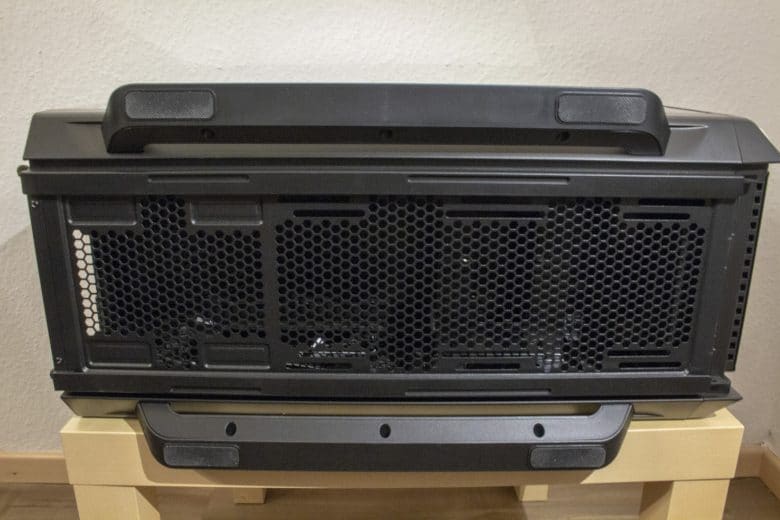
The simple design also continues inside. All surfaces are black or very dark. What is immediately noticeable is the very open room design and the enormous space for hardware. As in its smaller brother, be quiet! follows the general trend with the Silent Base 801 and has implemented a power supply cover and rubber linings for the cable openings. All in all, the cable management system is very well thought out and offers a lot of space for laying the cables.
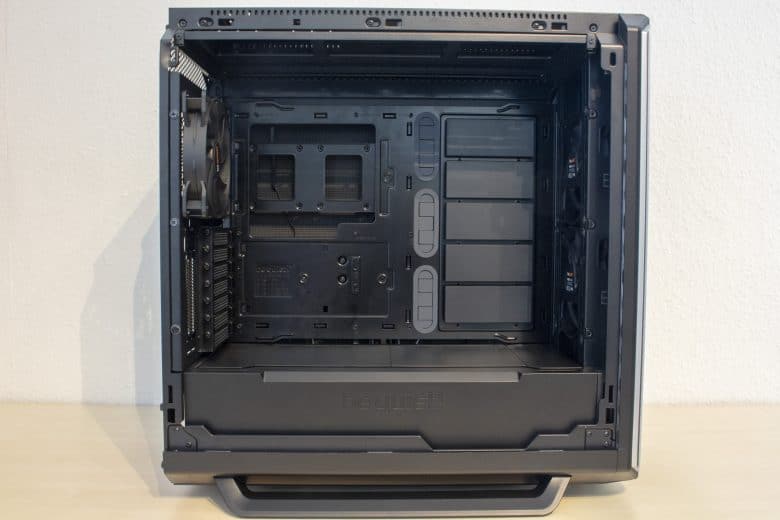
Workmanship
With a price from Product the Silent Base 801 is in the middle class. According to the price and the previous experience with be quiet! products, the workmanship is on a very high level. Steel, plastic and tempered glass were used in the production process. The paintwork is perfect and the gap dimensions also fit. Despite the use of plastic elements for the feet, the front and the power supply cover, the Silent Base 801 looks solid and weighs approx. 10.5 kg.
The feel of the buttons on the I/O panel and the fan control are very good.
All in all, the be quiet! Silent Base 801 has no complaints about the workmanship quality.
Equipment
The be quiet! Silent Base 801 officially belongs to the midi tower range with seven PCI slots, but due to its external dimensions and a volume of approx. 85 litres it has a much larger footprint than a conventional midi tower. But very large hardware also fits into these cases. In addition to E-ATX mainboards, the buyer can also install CPU coolers up to 185 mm, graphics cards up to 449 mm and power supplies up to 288 mm. To ensure that the installed hardware is also supplied with sufficient fresh air, be quiet! has pre-installed a total of three Pure Wings 2 with a frame size of 140 mm. All three fans are connected to a PWM-capable control board for a total of six fans.
| Model: | Silent Base 801 |
| Housing type: | Midi Tower |
| Dimensions: | 282 mm (W) x 552 mm (H) x 539 mm (D) |
| Material: | Steel, Plastic, Tempered Glass |
| Color: | Black, Black/Silver, Black/Orange |
| Front connections | 2x USB 3.0, 1x USB 2.0, 1x headphones, 1x microphone, 4-stage fan control |
| Drive bays: | 2x 3,5″, 3x 2,5″ |
| Extension slots: | 7 + 2 |
| Form factors: | E-ATX, ATX, mATX, mini-ITX |
| Ventilation: | Front: 3x 120 mm / 3x 140 mm Rear: 1x 120 mm / 1x 140 mm Top: 3x 120 mm / 3x 140 mm PSU cover: 1x 120 mm / 1x 140 mm |
| Radiators: | Front: 420 mm / 280 mm / 140 mm / 360 mm / 240 mm / 120 mm Cover: 360 mm / 240 mm / 120 mm Rear: 140 mm / 120mm |
| Max. CPU cooler height: | 185 mm |
| Max. Graphics card length: | 287 mm (with HDD cage) 449 mm (without HDD cage) |
| Max. Power supply length: | 288 mm |
| Cable management space: | 35 mm |
| Price: | Product |
| Other features: | modular power supply cover, modular or invertible mainboard slide, fan control (up to 6 fans, PWM connector) |
For buyers who want to install water cooling in the Silent Base 801, the housing offers space in the front for radiators up to 420 mm in length and in the lid up to 360 mm. Since the lid is fixed, be quiet! has integrated a clever solution for mounting the lid radiator. After loosening two screws, a practical mounting frame can be pulled out in the upper area. After the radiator has been assembled, the frame is simply pushed back again and screwed into place. However, it is somewhat questionable whether a large radiator can be used effectively here due to the small cover openings. I will examine this topic in more detail in the next chapter.
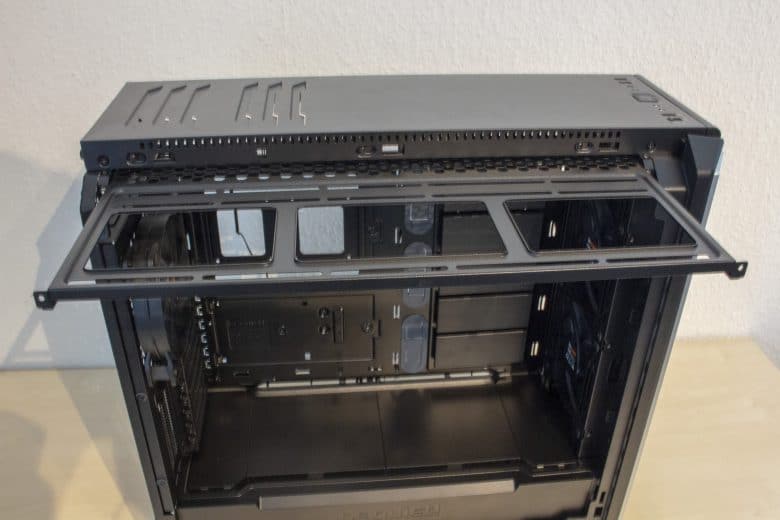
A special feature of be quiet! is the removable or invertible mainboard carriage. This feature makes it possible for the buyer to decide for himself whether to place the PC on its left or right side. This is particularly practical for the variant with side window.
System Construction in Silent Base 801
Now we come to system installation. As hardware I use a Intel Xeon 1230v3 on a Gigabyte H87M-D3H with 16 GB RAM. The Xeon is identified by Arctic Freezer 240 All-in-One water cooling cooled in a push-pull configuration. An HD 7850 2GB from Asus is responsible for the image output. For the whole system to work, it is powered by the non-modular be quiet! Pure Power 10 400W*.
The installation of all parts was done very quickly and due to the generously designed interior also possible with large hands. In addition, the pre-installed spacers have made installation easier. What one could miss here is a screwdriver attachment to be able to change the spacers if necessary. In this case a pair of pliers had to be used. All in all, however, the finished system can be seen well in my eyes.
The water cooling can be installed either in the front or in the cover. In this case, I decided to mount it in the lid so that I could take a closer look at the removable mounting frame. Due to the offset mounting rails, it was possible to mount the Arctic Freezer 240 with a total thickness of approx. 9 cm without any problems. But that only worked because the RAM bars and the mainboard don’t have high heatspreaders. After removing the power supply cover, approx. 55 cm for a radiator are available in the front.
The wiring of the system was also quickly completed. The power supply cover and the well placed and rubberized cable openings make the system look very neat. In addition, the 35mm space behind the mainboard sled contributes to this result. Even if the cables of the power supply unit are on top of each other, the side panel can be easily closed.
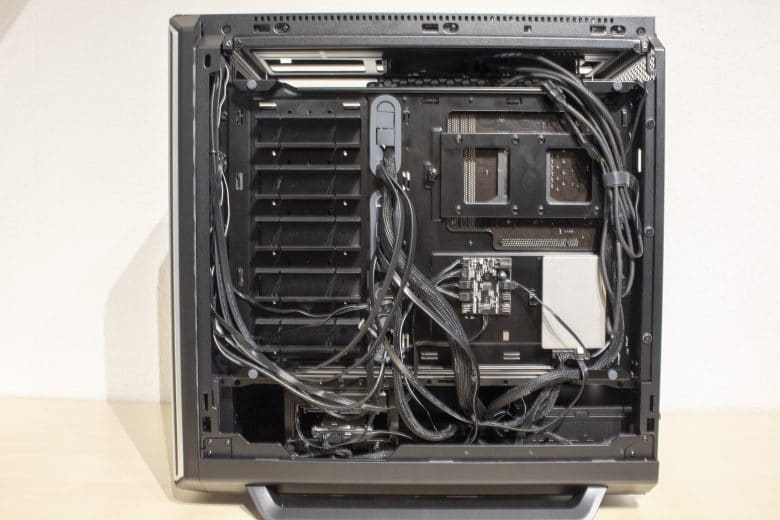
The Silent Base 801 offers numerous options for accommodating data media. Two 3.5″ or two 2.5″ HDDs can be accommodated in the hard disk cage under the power supply cover. For decoupling these frames have thick rubber discs which are coloured in the accent colour (black, grey or orange) of the housing. Three more 2.5″ devices can be placed directly behind the mainboard. For buyers who need even more space for additional data storage, be quiet! includes three additional mounting frames for one 3.5″ or one 2.5″ hard disk each. To mount these frames, which also have rubber decouplers, one of the six plastic covers must be removed. Afterwards the fastening is done with three knurled screws. But it is important to mention that by using these frames the maximum graphics card length decreases to 267mm and radiators in the front can no longer be mounted.
As standard be quiet! equips the Silent Base 801 with three Pure Wings 2 fans with a frame width of 140mm. These have a maximum speed of 1500 rpm and are connected ex works to the PWM-enabled fan controller. What is unfortunately noticeable during operation is that the fans on the middle and highest of three levels are simply too loud for a silent case. At the lowest level they are significantly quieter, but then slight bearing noises can be heard. So absolute silent enthusiasts have to retrofit here again.
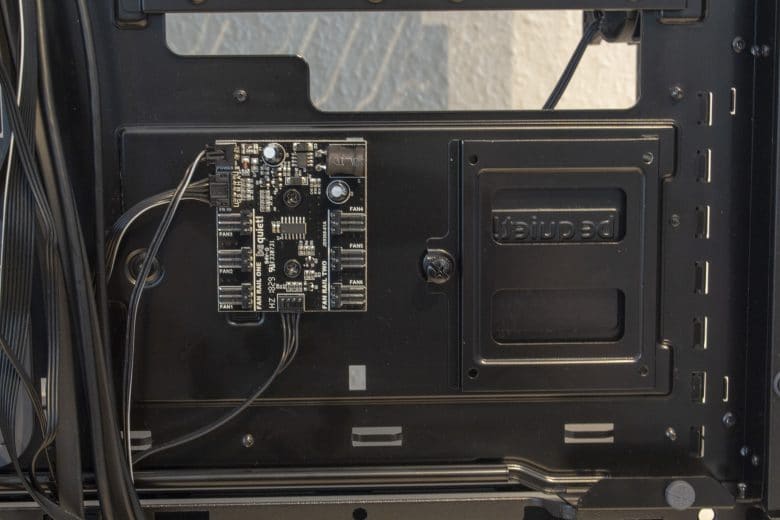
As last special feature the decoupled and invertible mainboard tray has to be mentioned. By loosening nine screws on the tray, it can be completely removed and turned 180°. Since the side panels can also be mounted on both sides, the buyer can rebuild the Silent Base 801 so quickly if he wants the case to stand to his left. However, you should be a little cautious during the conversion, as there is a possibility that the mainboard slider could be slightly tilted and the varnish could be damaged. Since be quiet! has also mounted the power supply cover modularly, it is also possible to maintain the well thought-out cable management during the conversion of the mainboard. Only the cable routing of the front I/O cables then has to be adapted.
Cooling Capacity
Of course, the heat development in Silent Base 801 was also checked. CPU and GPU were brought to 100% load by Prime95 or FurMark and after 15 minutes the temperature was measured with the tool CPUID Hardware Monitor. The fan profiles were set to “Silent” via the BIOS and the case fans were set to the lowest level via the integrated fan control. After the 15 minutes measurement time, the temperature for the CPU was 67 °C and for the GPU 70 °C. These values are acceptable for an insulated housing.
But since I wanted to check if the six openings in the lid were too restrictive to dissipate the waste heat of a large radiator, I installed the radiator once in the front and put a Pure Wings 2 fan in the lid. With temperatures of 60 °C for the CPU and 72 °C for the GPU, the result is a lot better, at least on the CPU side. In addition, the system is subjectively quieter. To complete the measurements I exchanged the AiO for the LC-Power Cosmo Cool LC-CC-120*. This is a normal tower cooler with 120 mm fan. In this configuration, the CPU reached 70 °C and the GPU 72 °C. The temperatures here are a bit higher again, but the system is felt quieter than with the AiO in the front.
Conclusion on the Silent Base 801 Review
All in all, the Silent Base 801 is a very well processed midi tower with a relatively large footprint. For a price of Product for the Window-version you get a very well equipped case with good silent features and a simple look. Due to the interior volume of almost 85 liters, the Tower takes up everything that can be found in the area of graphics cards or CPU cooling. Due to the modular power supply cover and the invertible mainboard tray, it is also possible to individualize the Silent Base 801 in a certain way. The high-quality tool-free fastening of both side parts also makes the installation and conversion of the system much easier. Fans of custom water cooling will probably not be happy with this case. Although the Silent Base 801 supports radiators up to 420 mm, the lid with the small openings is not really designed for the waste heat of a 360 mm radiator. With a 360 radiator, two of the three fans would simply blow the waste heat against the cover or insulation.
As with the Silent Base 601, the main focus of the Silent Base 801 was on the silent properties. The Midi-Tower is a good basic structure for a whisper-quiet system. As always, however, the prerequisites here are quiet components and, for very sensitive buyers, the exchange of pre-installed fans.
Last but not least, it is also important to take a look at the “competition”. The Dark Base 700* from our own company currently costs about 10 € more than the Silent Base 801 with side window and is a bit smaller with an interior volume of 68 liters, but it comes with two higher quality fans from the Silent Wings series ex works and also offers a USB type C port in the front. All in all, I think it is the better alternative from a current point of view.
be quiet! Silent Base 801
Workmanship
Features
Structure
Cooling
Value for Money
A large midi tower with lots of space, invertible interior and very good noise insulation.

